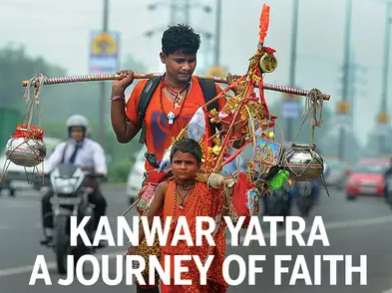Kanwar Yatra or popularly known as kanwad Yatra, is the annual pilgrimage in the worship of Lord Shiva. In this annual pilgrimage, the devotees of Lord Shiva go to Hindu pilgrimage places and bring water from the holy river Ganga and fetch water from river Ganga. The same Ganga water is offered to Shivlinga in the local Shiva temples. Sultanganj in Bihar, Gangotri, and Gaumukh in Uttrakhand and Haridwar is the most popular Hindu pilgrimages to fetch holy water from.
 Kanwar Yatra usually takes place in July or August. It corresponds to the Hindu month of Sharavan. However, the Kanwar Yatra that is related to Sultanganj to Devgar in Bihar and Jharkhand is undertaken a year long. In this Kanwar yatra from Bihar to Devgarh, the devotees walk barefoot with utmost enthusiasm and devotion.
Kanwar Yatra usually takes place in July or August. It corresponds to the Hindu month of Sharavan. However, the Kanwar Yatra that is related to Sultanganj to Devgar in Bihar and Jharkhand is undertaken a year long. In this Kanwar yatra from Bihar to Devgarh, the devotees walk barefoot with utmost enthusiasm and devotion.
Kanwar Yatra – Annual Pilgrimage
Initially, the Kanwar Yatra was observed during the month of Bhado. It was later that it started to take place in the month of shravan. It was from the year 1960 with the start of a mela, the time of the Yatra shifted to Shravan month and it lasts by the festival of Dussehra.
The two significant Hindu festivals “Basant Panchmi” and “Maha Shivratri” are observed during this period, and these two festivals increase the enthusiasm of Kanwaris manifold.
According to statistics, around 2 crores of Kanwaris perform Kanwar yatra every year. The yearly “Shravan mela” is one of the biggest fates organized in North India. The religious congregation will be similar during Kanwar yatra dates this year as well.
The most interesting part is that the festival is not related to men only. Women participate in this festival with equal enthusiasm and devotion.
Also Check : Which date has Raksha Bandhan in 2023?
Kanwar Yatra 2023 Dates
This year Kanwar yatra 2023 date is Tuesday, 4th of July. The Yatra will commence from this date and will last until the festival of Dussehra. The Kanwar Yatra 2023 will ends on 18th July with Sawan Shivratri, while the Jal time is between 12:41 AM to 12:55 AM on July 19, 2023.
The Rituals of Kanwar Yatra
One of the most engrossing rituals of this Yatra is how Kanwar is carrying the Kanwar. They carry it around on both of their shoulders. Kanwar is a small bamboo pole where two earthen pots are tied on both ends of the pole. Both the earthen pots are beautifully decorated. The Kanwar is also decorated with colorful dupattas and hangings.
During their journey, the kanwaris fill the pots with the holy Ganga water and perform their return journey by balancing the full pots on their shoulders. Upon reaching back to their hometown, they use this holy water to shower the Shivlinga of the local temple.
It is a month-long ritual. The Kanwar’s wear saffron clothes and walk barefoot to reach their pilgrimage destination. They reach their destination, collect water from there, and return to their hometown to do “abhishekam” of their deity.
The Kanwar yatra and abhishekam is considered as the thanksgiving. The devotees thanks Lord Shiva for what they have got in their lives and pray for what they desire to achieve.
During the whole journey, they have to make sure that the earthen pots should not touch the floor. That is why; different types of makeshift stands are created so that kanwaris can take a rest without breaking any ritual.
Kanwaris make sure to walk in groups during this Yatra. While most of them walk barefoot or at least on their foot, some of them use bicycles, scooters, and even cars to complete their journey. They chant ‘Bam bam Bhole’ and religious bhajans throughout their journey.
Not only taking kanwars but serving the kanwaris also considered auspicious. There are several NGOs and temple committees that serve kanwaris on their way. Their noble acts include offering food, water, and snacks to kanwaris on their way. Medical help is also a significant part of their services.
These committees work actively throughout the month of Shravan. Such NGOs work on a donation and are exempted from any income tax.
Significance of Kanwar Yatra
The yearly ritual has its significance. Kanwaris consider it as a spiritual break where they cut off ties from the materialistic world and devote all their time and energy to the worship of their deity. It can also be considered a break from the negativity and stress of routine life. They give their all to take blessings from Lord Shiva.
Also, Read:
- Dhanteras 2023: Shubh Muhurat and Puja Timings
- Benefits of Twelve Mukhi Rudraksha
- Astrology Remedies For Successful Business
- Black Cat Crossing Path Spiritual Meaning
